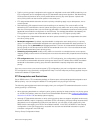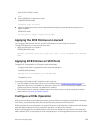
• Traffic may be interrupted when you reconfigure PFC no-drop priorities in a DCB map or re-apply the
DCB map to an interface.
• For PFC to be applied, the configured priority traffic must be supported by a PFC peer (as detected by
DCBx).
• If you apply a DCB map with PFC disabled (pfc off), you can enable link-level flow control on the
interface using the flowcontrol rx on tx on command. To delete the DCB map, first disable
link-level flow control. PFC is then automatically enabled on the interface because an interface is
PFC-enabled by default.
• To ensure no-drop handling of lossless traffic, PFC allows you to configure lossless queues on a port
(see Configuring Lossless Queues).
• When you configure a DCB map, an error message is displayed if the PFC dot1p priorities result in
more than two lossless queues.
• When you apply a DCB map, an error message is displayed if link-level flow control is already enabled
on an interface. You cannot enable PFC and link-level flow control at the same time on an interface.
• In a switch stack, configure all stacked ports with the same PFC configuration.
• Dell Networking OS allows you to change the default dot1p priority-queue assignments only if the
change satisfies the following requirements in DCB maps already applied to S6000 interfaces:
• All 802.1p priorities mapped to the same queue must be in the same priority group.
• A maximum of two PFC-enabled, lossless queues are supported on an interface.
Otherwise, the reconfiguration of a default dot1p-queue assignment is rejected.
• To ensure complete no-drop service, apply the same PFC parameters on all PFC-enabled peers.
PFC Prerequisites and Restrictions
On an S6000 switch, PFC is globally enabled by default, but not applied on specific 802.1p priorities. To
enable PFC on 802.1p priorities, create a DCB map.
The following prerequisites and restrictions apply when you configure PFC in a DCB map:
• You can enable PFC on a maximum of two priority queues on an interface. Enabling PFC for dot1p
priorities configures the corresponding port queue as lossless.
• You cannot enable PFC and link-level flow control at the same time on an interface.
ETS Configuration Notes
ETS provides a way to optimize bandwidth allocation to outbound 802.1p classes of converged Ethernet
traffic. Different traffic types have different service needs. Using ETS, you can create groups within an
802.1p priority class to configure different treatment for traffics with different bandwidth, latency, and
best-effort needs.
When you configure ETS in a DCB map:
• The DCB map associates a priority group with a PFC operational mode (on or off) and an ETS
scheduling and bandwidth allocation. You can apply a DCB map on multiple egress ports.
• Use the ETS configuration associated with 802.1p priority traffic in a DCB map in DCBx negotiation
with ETS peers.
252
Data Center Bridging (DCB)


















